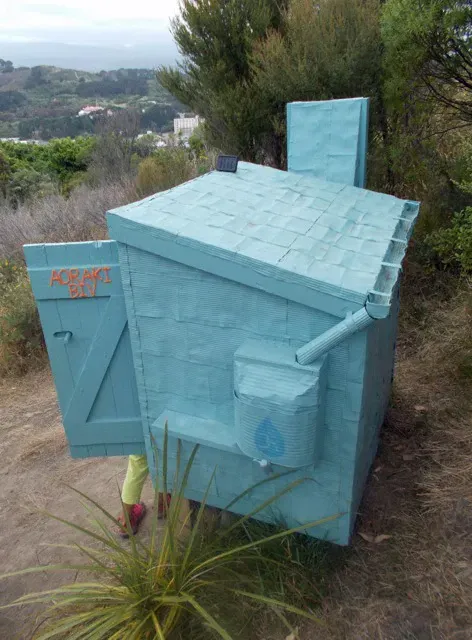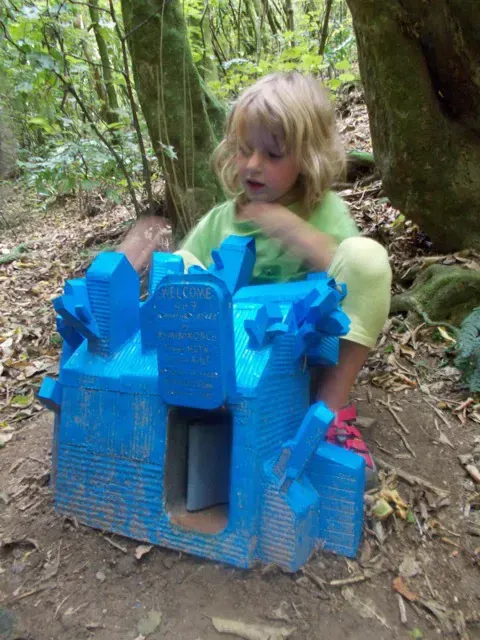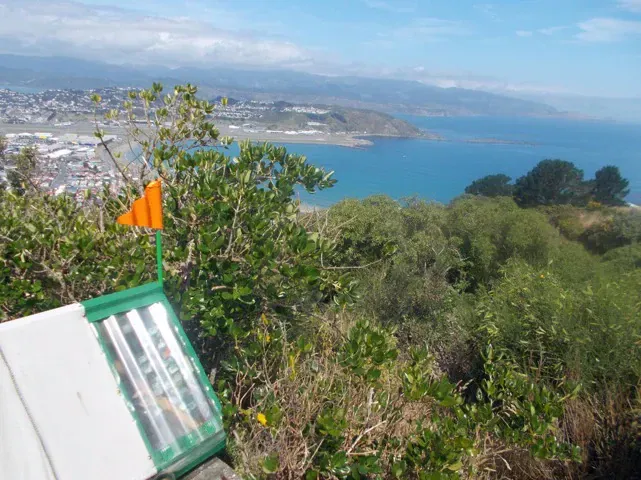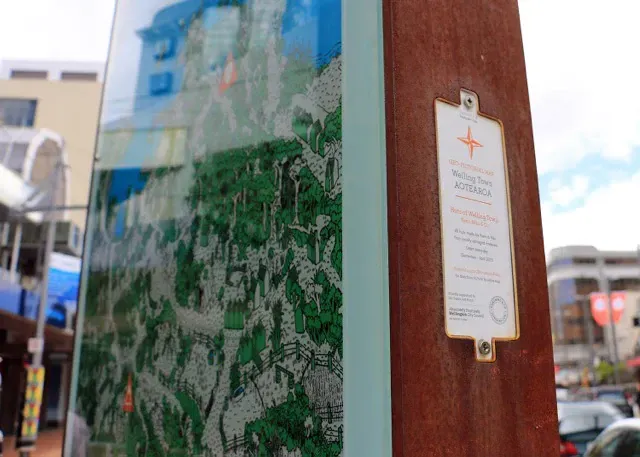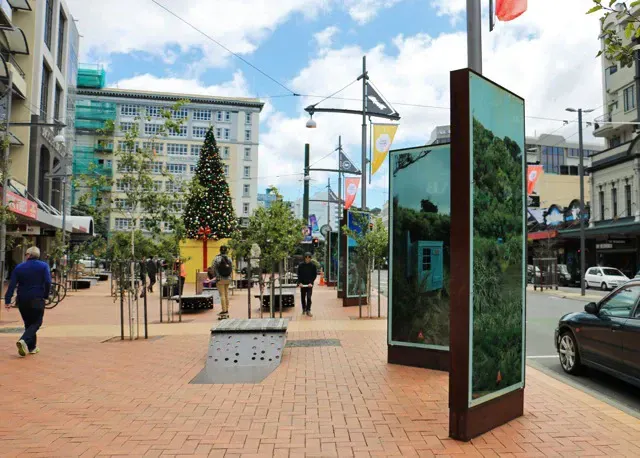A Treasure Hunt
Written by
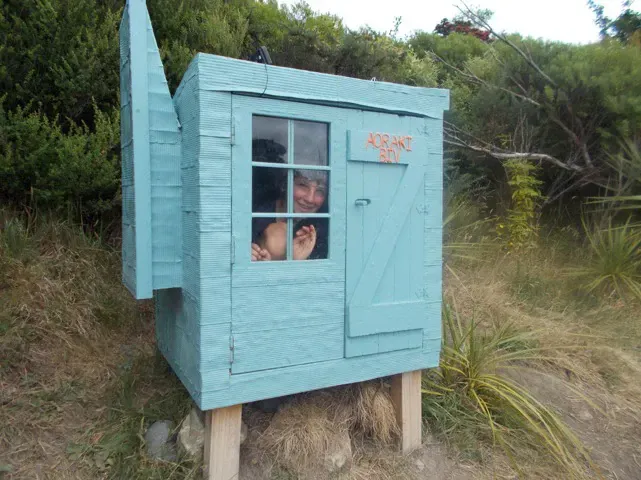
By Mark Amery
We treasure the little things because they connect us: a passing comment, a fleeting sighting, or a found object that fits in the hand. They are often shared rather than owned. In summer, moving more outside our usual habitat, I suspect we have more space for these things.
Last week my three children and I looked down on central Wellington from a scrubby patch beneath a eucalyptus tree in the town belt, between Mount Cook and Brooklyn. Despite the city view it felt miles away. Pohutukawa in bloom framed the view, tui sang and danced, and down below at the Basin Reserve, Kane Williamson and BJ Watling were busy breaking the world record for a sixth wicket stand.
This was Aoraki Biv, one of seven miniature huts (or clusters of huts) placed in carefully selected wild spots, just off the trodden paths around Wellington city. The Miniature Hikes project is the work of artists Kemi Whitwell and Niko Leyden, who go under the name Kemi Niko and Co. The Co they say stands for ‘connective’. Their work seeks to make connections, but it also needs public contribution to be realised.
When we arrived at Aoraki a family were ticking off the last of the hikes. A full 'Intentions Book' (full of experiences, stories and drawing) attested to the popularity of the project. Placed in lesser-known sites around the city, you can imagine the stories of these huts passing between people at BBQs all summer. A tribute to tramping, rugged geography, makeshift kookiness and the theatre of happenstance there is something very Wellington about the project.
The huts range in scale from tiny to Aoraki, which is big enough to snugly fit as a playhouse for my three children. Or seat two adults to enjoy a moment and the view. As huts have been scaled down in size so have the tramps. Aoraki Biv is a minute or two off a concrete path but there are no signs, so it still requires taking a few hunches following directions from the website. Like the bright, unexpected sight of a hut through the trees after a long walk, or the joys of a childhood treasure hunt there’s the discovery of little miracles.
Aoraki is a cheeky reference to the other Mount Cook. It’s a mountaineering hut. ‘Biv’ meanwhile (such a expression of New Zealand make-do remoteness) marks this as a small temporary shelter. Like other huts in the series it responds thoughtfully in form and features to tramping hut design history, and the human quirks that makes the experience of them special.
Made from recycled materials the exterior is clad in corrugated tin from tin cans, and includes a chimney (across the series there is exploration of the boxy charms of the hut flue), and guttering and piping lead to a working water tank, providing visitors with fresh rainwater.
Little things collect. Alongside the Intentions Book, inside behind an old wooden framed window (reminiscent of those still to be found in older huts) were cushions, tea bags, two wine glasses held behind a shelf carefully made from pieces of branch, solar powered fairy lights and a book of nursery rhymes. Comforts that make you feel welcomed and like staying for a while. And that make you feel like giving in return – as well as stories and drawings there were various other small gifts left behind. My six year old was enamoured with a wee plastic frog.
On one of the pieces of wooden wall studs is painted a poetic welcome text. Like other drawn decoration in some of the other sites, I’m not sure in its wooliness it helps keep the project open, but its sentiments about providing sanctuary and generosity are in keeping. Later in the week I take my first tramp in years to historic Field Hut in the Tararuas and notice the small gifts left behind by others, individual’s texts inscribed in the walls.
Before the Black Caps have declared for the day we’ve visited two other huts - magic sites in Wellington we’ve never been to before. Up the end of Aro Valley’s Holloway Road (itself a quirky, crooked hidden treasure) a trail up the creek below the bending trees, skirting clusters of newly unfurled ferns and passing by a temporary memorial to someone who has passed, made from found material strung from bright ribbons between trees, is Crystal Hut. A small dolls house or giant piece of jewellery, with a tin can cavity behind a flap up door for the logbook, chimneys, tanks and shelters sprout surreally off its sides in all directions, like natural crystalline growths.
Then we take a steep hill climb behind the zoo to Mount Albert, with magnificent 360 views across the city and the harbour heads. An easily missed path through the gorse brings you to the concrete skeleton of an old small military bunker, perched upon which is a tent-like enclosure for the head, made from corrugated clear light, tin, wood and canvas. A tiny shelf with pen, pins and paper before a blackboard allow you to share your thoughts while looking out through the clear light. Entitled Portal, like some camera obscura apparatus, it creates a shared sheltered private space for the collection of impressions.
There is a playful diversity of form and function across the seven pieces placed around the city, experimenting in scale with how we relate to the sites in which they sit. Or in one case hang – there’s a tiny A-shaped tin shelter with a faux chimney hung in a tree up Mount Victoria, akin to a birdhouse and a trampers’ cool store.
In their design of the project Kemi Niko and Co have resisted uniformity. Each site has been developed in response to both the different kinds of temporary shelters to be found in our wilderness but also feedback gathered through logbooks near the sites last year from local communities. While it might lack the visual slickness and consistency of other public contemporary art projects, the idiosyncrasies feel appropriate for a project that seeks to marry the artists’ ideas with the use of these locations by the community. It echoes the way huts develop as open community spaces with add-on lean tos here and there. The open-endedness of the project is key to the strength of its engagement.
Bringing documentation of the project together are displays in the Courtenay Place Public Art light boxes. Here through photography and design you get to appreciate the project’s visual scope. Each hut is painted either aquamarine blue or hazard orange, standing out like emergency beacons against the green. As designers Kemi Niko have also produced a series of nifty if inconsistent icons (like map navigational markers) for each site. The photography is not as crisp in definition as it could be for the lightboxes scale, but the images delight in their play with our sense of scale. A brightly painted miniature hut placed in a small area of tussock can make it seem like a grand, distant wilderness.
Miniature towns or model villages were all the rage in the UK mid 20th century. This project is like a more interactive and creative variation on such an idea, reflecting a distinct aspect of this country. In a set of strong topographical cartoons of Wellington in the Lightboxes, there’s a play on the whimsy and nostalgia of holiday hiking adventures, the world made small, as found in the Famous Five and Rupert-era of children’s literature. Kemi Niko present 'Welling Town', the city transformed into a bucolic and gentle semi-rural place in which to ramble. It is neither of past or the future, and there is no trace of Maori I can see. Patches of bush, fields and paths dominate the roads, buildings and recognisable capital’s icons. Like some rural idyll, the airport runway is cracked and overgrown. You may freely roam anywhere, considering every piece of land a potential camping site.
Just as it was up at Aoraki Biv, everything is brought down to human scale, gentle and bucolic. Rather successfully, Miniature Hikes redraws the map of a city for public dreaming.
- Miniature Hikes and Huts of Welling Town, Kemi Niko and Co, until 31 March
